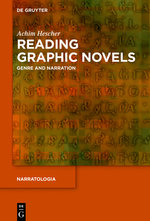
Achim Hescher, Reading Graphic Novels. Genre and Narration
Berlin, Boston: de Gruyter, coll.«Narratologia», 2016.
EAN13: 9783110445237
219 pages
69.95 EUR
Présentation de l'éditeur
Distinguishing the graphic novel from other types of comic books has presented problems due to the fuzziness of category boundaries. Against the backdrop of prototype theory, the author establishes the graphic novel as a genre whose core feature is complexity, which again is defined by seven gradable subcategories: 1) multilayered plot and narration, 2) multireferential use of color, 3) complex text-image relation, 4) meaning-enhancing panel design and layout, 5) structural performativity, 6) references to texts/media, and 7) self-referential and metafictional devices. Regarding the subcategory of narration, the existence of a narrator as known from classical narratology can no longer be assumed. In addition, conventional focalization cannot account for two crucial parameters of the comics image: what is shown (point of view, including mise en scène) and what is seen (character perception). On the basis of François Jost’s concepts of ocularization and focalization, this book presents an analytical framework for graphic novels beyond conventional narratology and finally discusses aspects of subjectivity, a focal paradigm in the latest research. It is intended for advanced students of literature, scholars, and comics experts.
Achim Hescher, Universität Koblenz-Landau, Germany.
Table des matières
1 Introduction
2 Beginnings, Periods, Movements, and Developments
2.1 Underground Roots
2.2 Alternative Comics and the First Hype of the Graphic Novel
2.3 The 1980s and 1990s: Significant Changes on the (Comic) Book Market
2.4 From 2000 on: the Second Hype of the Graphic Novel
2.5 Graphic Novels and bandes dessinées
3 Graphic Novels and the Problem of Categorization
3.1 Academic Interest in Comics and Graphic Novels
3.2 General Categorization Criteria for Graphic Novels
3.2.1 Lengthiness and Serialization
3.2.2 Seriousness and Authenticity
3.2.3 Cartoonicity
3.2.4 Complexity
3.3 From Prototypes to a Typology of Complexity
3.3.1 Format, Medium, Mode, and Genre
3.3.2 From Classical Categories to Family Resemblances
3.3.3 Fuzzy Boundaries: From Family Resemblances to Prototypical Categories
3.3.4 From Prototypes to a Typology
3.3.4.1 Multilayered Plot and Narration
3.3.4.2 Multireferential Use of Color
3.3.4.3 Complex Text/Image Relation
3.3.4.4 Meaning-Enhancing Panel Design/Layout
3.3.4.5 Structural Performativity
3.3.4.6 Multiplicity of References to Texts/Media
3.3.4.7 Self-Referential Narration and Metafictional Devices
3.3.5 A Short Parenthesis on Autobiography
3.4 Critical Approaches to Comics and Graphic Novels
3.4.1 Will Eisner’s Practical Sequentiality
3.4.2 Scott McCloud’s (Mis)Understanding of Comics
3.4.3 Charles Hatfield’s Alternatives to Sequentiality
3.4.4 Thierry Groensteen’s Visual Arthrology
3.4.5 Martin Schüwer’s Comprehensive Intermedial Approach
3.4.6 Hannah Miodrag’s Langue vs. Parole in the “Web” of Comics
3.4.7 Conclusion
4 Verbal and Pictorial Narration in Graphic Novels
4.1 Preliminary Reflections: Why Graphic Narratives Have no Transmitting Communication System and not Necessarily a Narrator
4.2 The Pictorial Track and Problems Concerning ‘Focalization’
4.3 Showing and Seeing in the Pictorial Narration
4.3.1 What Is Shown and What Is (not) Seen: Mise en Scène vs. Character Vision
4.3.1.1 Showing Taken to the Extreme: Cross-Cutting Strands of Action/Montage
4.3.1.2 Mise en Scène and Ocularization
4.4 Words and Text as Showing and Narrating
4.4.1 Paratext
4.4.2 Narratorial Captions
4.4.3 Balloons and Balloon Speech
4.4.4 An Excess of Showing: Sounds and Lettering
4.4.5 Texts in the Fictional World
4.4.6 Tags
4.5 Of Authors, Artist-Writers, and Narrators
4.6 Narratorial and Pictorial Representation in Graphic Memoirs and Fictional Biographies
4.7 Why the Narrating and Experiencing I Should Not Be Used on the Graphic Memoir
4.8 Focalization Revisited: What Is Known and What Is Shown
4.9 Representations of Subjectivity
4.9.1 Styles and Their Makers
4.9.2 The Subjectivity of Characters
4.9.3 Character Imagination
4.9.4 The Subjectivity of Narrators
4.9.5 Signs and Metaphors of Subjectivity
4.10 Layout Revisited: Classification and Critical Efficiency
5 Taking Stock: The Graphic Novel as a Narrating Genre
6 Works Cited
6.1 Primary Verbal and Graphic Works
6.2 Secondary Works
7 Index of Primary Works